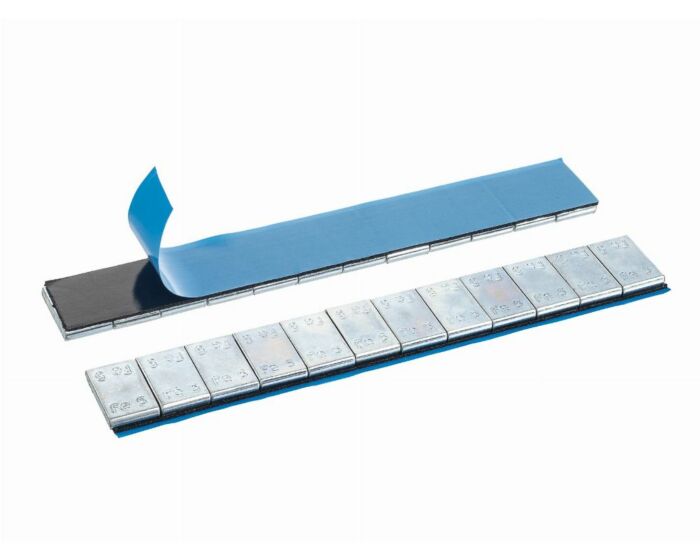We use cookies to make your experience better. To comply with the new e-Privacy directive, we need to ask for your consent to set the cookies. Learn more.
ALU SLIM FE1 12 X 5 g adhesive wheel weight
PromoProduct category: Steel (Fe) wheel weights
Price for: 100 per box
SLIM 60g (12 x 5g) steel adhesive wheel weight, zinc-coated, square shape, with wide tape. The ideal solution that guarantees precise balancing of passenger car alloy wheels.
- Details
-
SLIM 60g (12 x 5g) steel adhesive wheel weight, zinc-coated, square shape, with wide tape. The ideal solution that guarantees precise balancing of passenger car alloy wheels. As a manufacturer of wheel weights, we offer products of the highest quality. Each batch of wheel weights is tested in our laboratory under strictly defined standards.
Advantages:
- Wide tape for easier mounting, which eliminates the need to take off the gloves
- Zinc coating for corrosion protection
- No risk of damaging the rim
- Thickness including the tape is only 4 mm, which makes the wheel weights practically invisible
- Convenient mounting and precise wheel balancing. A single piece of wheel weight consists of a 60g strip additionally divided into 12 smaller, 5g wheel weights.
- The wheel weights adapt perfectly to the rims thanks to elastic tape.
- Strong adhesive tape for permanent mounting of the wheel weight on the rim
- Technical data
-
- Material: steel
- Protective coating: zinc
- Type: adhesive weights
- Mounting method - stick on the rim
- Dedicated to: aluminum rim
- Height: 3.8 mm
- Shape: square
- Color: silver
- Securing adhesive tape: blue, wide
- Weight of the weight: 5 grams
- Strip weight: 60 grams
- Package weight: 6 kg
- Number of weights on the strip: 12 pcs
- Number of strips in the package: 100 pcs
- Number of packages: 1 package
- Condition: New
- Catalog item: EXPTPALU-FE1
- Manufacturer's code: EXPTPALU-FE1
- Warranty
-
Warranty: 12 months
- Safety
-
- Responsible Producer:
-
TIPTOPOL SP. Z O.O.
ul. Kostrzyńska 33
62-010 Pobiedziska
Poland
sklep@tiptopol.pl
+48618152200
Mechanical risks
The product has movable parts that can cause a variety of mechanical hazards during operation, which can lead to serious injuries.
Crushing and crushing: There is a risk that the moving parts of the product will crush or crush the body. It can lead to serious injury or permanent injury.
Cuts and punctures: Cuts, cuts, and even deeper injuries can occur if the user comes into contact with sharp edges or product components.
Impact and Fall Injuries: These can occur when objects fall over and fall from a height or are moved in an improper and dangerous manner. This can cause serious injuries, including broken bones and head injuries.
Trapping: If a body part becomes trapped between moving parts, it can lead to serious injury and loss of limbs.
Vibration: Exposure to prolonged vibration while using the device can damage muscles and nerves. This can lead to vibration syndrome, causing pain and dysfunction in the limbs.
To minimise these risks, it is recommended to use appropriate personal protective equipment, regularly inspect and maintain the equipment, and follow all manufacturer's recommendations for safe use and health and safety (Occupational Health and Safety) regulations.
Chemical risks
When using chemical products, a variety of chemical hazards can occur, which can lead to serious consequences.
Chemical spills: These can occur due to packaging damage, misstorage, or misuse. Spills lead to environmental contamination, property damage and exposure of human health to toxic substances.
Chemical reactions: Uncontrolled chemical reactions can occur when different chemicals interact. This can lead to explosions, fires or the release of harmful gases that can be dangerous to health and life.
Corrosion and degradation of materials: Certain chemicals can cause corrosion and degradation of materials they come into contact with. This can lead to a weakening of the structure of materials, which in turn can cause equipment and structures to fail.
Poisoning: Improper use of chemical products can lead to inhalation, ingestion, or absorption through the skin. This can lead to poisoning, which can have serious health effects and even be life-threatening.
To minimize these risks, it is recommended to read the information on the packaging and in the safety data sheets, use appropriate personal protective equipment, follow safety procedures, regularly inspect equipment in which chemicals are used to check for tightness and correct closure of packaging, and appropriate storage and use of chemicals.
Environmental risks
A variety of environmental hazards can occur during the use and disposal of products, which can lead to serious consequences.
Environmental pollution: Products, especially those containing chemicals or plastic, can contribute to soil, water, and air pollution. This can lead to the degradation of ecosystems, groundwater and surface water pollution, and negative impacts on human and animal health.
Improper disposal of products: Improper waste management can lead to the uncontrolled spread of toxins and contaminants. This can result in severe environmental pollution, risks to public health, and the loss of valuable natural resources through a lack of recycling.
Electronic waste (e-waste): Electronic products, when not properly disposed of, can become a source of e-waste containing harmful chemicals and heavy metals. This can lead to soil and water contamination, as well as pose a risk to human and animal health.
To minimise environmental risks, it is recommended to manage waste appropriately, including segregation and compliance with environmental regulations.


